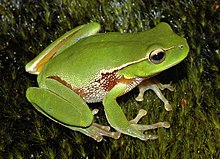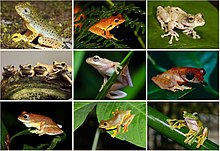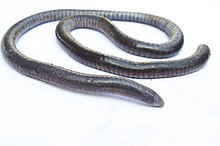Portal:Amphibians
The Amphibian Portal
Amphibians are ectothermic, anamniotic, four-limbed vertebrate animals that constitute the class Amphibia. In its broadest sense, it is a paraphyletic group encompassing all tetrapods, excluding the amniotes (tetrapods with an amniotic membrane, such as modern reptiles, birds, and mammals). All extant (living) amphibians belong to the monophyletic subclass Lissamphibia, with three living orders: Anura (frogs), Urodela (salamanders), and Gymnophiona (caecilians). Evolved to be mostly semiaquatic, amphibians have adapted to inhabit a wide variety of habitats, with most species living in freshwater, wetland or terrestrial ecosystems (such as riparian woodland, fossorial and even arboreal habitats). Their life cycle typically starts out as aquatic larvae with gills known as tadpoles, but some species have developed behavioural adaptations to bypass this.
The young generally undergo metamorphosis from larva with gills to an adult air-breathing form with lungs. Amphibians use their skin as a secondary respiratory surface and some small terrestrial salamanders and frogs lack lungs and rely entirely on their skin. They are superficially similar to reptiles like lizards, but unlike reptiles and other amniotes, require water bodies in which to breed. With their complex reproductive needs and permeable skins, amphibians are often ecological indicators; in recent decades there has been a dramatic decline in amphibian populations for many species around the globe.
The earliest amphibians evolved in the Devonian period from sarcopterygian fish with lungs and bony-limbed fins, features that were helpful in adapting to dry land. They diversified and became ecologically dominant during the Carboniferous and Permian periods, but were later displaced in terrestrial environments by early reptiles and basal synapsids (mammal predecessors). The origin of modern amphibians belonging to Lissamphibia, which first appeared during the Early Triassic, around 250 million years ago, has long been contentious. However the emerging consensus is that they likely originated from temnospondyls, the most diverse group of prehistoric amphibians, during the Permian period. (Full article...)
Selected frog article
The Rhacophoridae are a family of frogs that occur in tropical sub-Saharan Africa, South India and Sri Lanka, Japan, northeastern India to eastern China and Taiwan, south through the Philippines and Greater Sundas, and Sulawesi. They are commonly known as shrub frogs, or more ambiguously as "moss frogs" or "bush frogs". Some Rhacophoridae are called "tree frogs". Among the most spectacular members of this family are numerous "flying frogs".
Although a few groups are primarily terrestrial, rhacophorids are predominantly arboreal treefrogs. Mating frogs, while in amplexus, hold on to a branch, and beat their legs to form a foam. The eggs are laid in the foam and covered with seminal fluid before the foam hardens into a protective casing. In some species, this is done in a large group. The foam is laid above a water source so the tadpoles fall into the water once they hatch.
The species within this family vary in size from 1.5 to 12 cm (0.59 to 4.72 in). Like other arboreal frogs, they have toe discs, and those of the genus Chiromantis have two opposable fingers on each hand. This family also contains the Old World flying frogs, including Wallace's flying frog (Rhacophorus nigropalmatus). These frogs have extensive webbing between their fore and hind limbs, allowing them to glide through the air. (Full article...)Selected salamander article
Sirenidae, the sirens, are a family of neotenic aquatic salamanders. Family members have very small fore limbs and lack hind limbs altogether. In one species, the skeleton in their fore limbs is made of only cartilage. In contrast to most other salamanders, they have external gills bunched together on the neck in both larval and adult states. Sirens are found only in the Southeastern United States and northern Mexico.
Although they are primarily carnivorous, they are the only salamanders observed eating plant material. (Full article...)List of selected salamander articles
|
|---|
Did you know? –

- ...that the Cheat Mountain salamander of West Virginia is the only vertebrate known to be unique to that state?
- ... that the Permian amphibian Trimerorhachis either brooded young in its mouth or ate them?
- ... that the Cumberland Dusky Salamander is believed to hybridize with the Ocoee Salamander?
- ... that female European cave salamanders do not normally eat while they guard their eggs for six months or more?
- ... that in hot weather, the eastern spadefoot toad (pictured) may aestivate in the deep burrow it has dug?
Selected amphibian type
Caecilians (/sɪˈsɪliən/; New Latin for 'blind ones') are a group of limbless, vermiform (worm-shaped) or serpentine (snake-shaped) amphibians with small or sometimes nonexistent eyes. They mostly live hidden in soil or in streambeds, and this cryptic lifestyle renders caecilians among the least familiar amphibians. Modern caecilians live in the tropics of South and Central America, Africa, and southern Asia. Caecilians feed on small subterranean creatures such as earthworms. The body is cylindrical and often darkly coloured, and the skull is bullet-shaped and strongly built. Caecilian heads have several unique adaptations, including fused cranial and jaw bones, a two-part system of jaw muscles, and a chemosensory tentacle in front of the eye. The skin is slimy and bears ringlike markings or grooves and may contain scales.
Modern caecilians are a clade, the order Gymnophiona' /ˌdʒɪmnəˈfaɪənə/ (or Apoda /ˈæpədə/), one of the three living amphibian groups alongside Anura (frogs) and Urodela (salamanders). Gymnophiona is a crown group, encompassing all modern caecilians and all descendants of their last common ancestor. There are more than 220 living species of caecilian classified in 10 families. Gymnophionomorpha is a recently coined name for the corresponding total group which includes Gymnophiona as well as a few extinct stem-group caecilians (extinct amphibians whose closest living relatives are caecilians but are not descended from any caecilian). Some palaeontologists have used the name Gymnophiona for the total group and the old name Apoda for the crown group'. However, Apoda has other even older uses, including as the name of a genus of Butterfly making its use potentially confusing and best avoided. 'Gymnophiona' derives from the Greek words γυμνος / gymnos (Ancient Greek for 'naked') and οφις / ophis (Ancient Greek for 'snake'), as the caecilians were originally thought to be related to snakes and to lack scales.
The study of caecilian evolution is complicated by their poor fossil record and specialized anatomy. Genetic evidence and some anatomical details (such as pedicellate teeth) support the idea that frogs, salamanders, and caecilians (collectively known as lissamphibians) are each others' closest relatives. Frogs and salamanders show many similarities to dissorophoids, a group of extinct amphibians in the order Temnospondyli. Caecilians are more controversial; many studies extend dissorophoid ancestry to caecilians. Some studies have instead argued that caecilians descend from extinct lepospondyl or stereospondyl amphibians, contradicting evidence for lissamphibian monophyly (common ancestry). Rare fossils of early gymnophionans such as Eocaecilia and Funcusvermis have helped to test the various conflicting hypotheses for the relationships between caecilians and other living and extinct amphibians. (Full article...)List of selected amphibian type articles
|
|---|
Selected images
Selected toad article
Rhinella, commonly known as South American toads, beaked toads or Rio Viejo toads, is a genus of true toads native to Neotropical parts of Mexico, Central and South America. Additionally, the cane toad has been Introduced to Australia, the Caribbean, the Philippines and elsewhere.
Originally, all species of the genus Rhinella were included in the genus Bufo, then they were split into the genera Chaunus and Rhamphophryne. However, Chaunus and Rhamphophryne are now considered synonyms of Rhinella. (Full article...)Selected caecilian article
Need help?
Do you have a question about Amphibians that you can't find the answer to?
Consider asking it at the Wikipedia reference desk.
Topics
Subcategories
Related portals
Associated Wikimedia
The following Wikimedia Foundation sister projects provide more on this subject:
-
Commons
Free media repository -
Wikibooks
Free textbooks and manuals -
Wikidata
Free knowledge base -
Wikinews
Free-content news -
Wikiquote
Collection of quotations -
Wikisource
Free-content library -
Wikiversity
Free learning tools -
Wiktionary
Dictionary and thesaurus












































